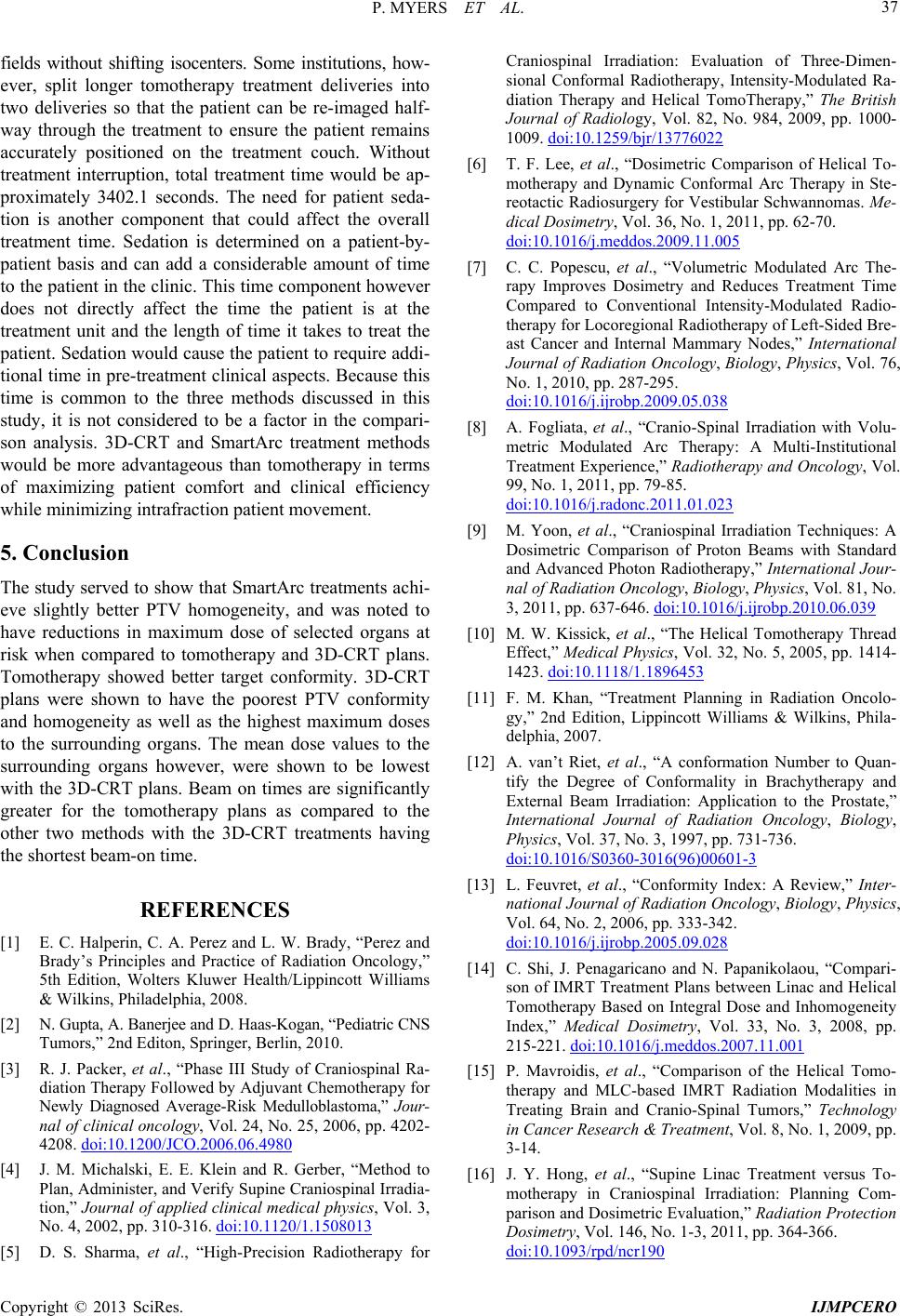
P. MYERS ET AL. 37
fields without shifting isocenters. Some institutions, how-
ever, split longer tomotherapy treatment deliveries into
two deliveries so that the patient can be re-imaged half-
way through the treatment to ensure the patient remains
accurately positioned on the treatment couch. Without
treatment interruption, total treatment time would be ap-
proximately 3402.1 seconds. The need for patient seda-
tion is another component that could affect the overall
treatment time. Sedation is determined on a patient-by-
patient basis and can add a considerable amount of time
to the patient in the clinic. This time component however
does not directly affect the time the patient is at the
treatment unit and the length of time it takes to treat the
patient. Sedation would cause the patient to require addi-
tional time in pre-treatment clinical aspects. Because this
time is common to the three methods discussed in this
study, it is not considered to be a factor in the compari-
son analysis. 3D-CRT and SmartArc treatment methods
would be more advantageous than tomotherapy in terms
of maximizing patient comfort and clinical efficiency
while minimizing intrafraction patient movement.
5. Conclusion
The study served to show that SmartArc treatments achi-
eve slightly better PTV homogeneity, and was noted to
have reductions in maximum dose of selected organs at
risk when compared to tomotherapy and 3D-CRT plans.
Tomotherapy showed better target conformity. 3D-CRT
plans were shown to have the poorest PTV conformity
and homogeneity as well as the highest maximum doses
to the surrounding organs. The mean dose values to the
surrounding organs however, were shown to be lowest
with the 3D-CRT plans. Beam on times are significantly
greater for the tomotherapy plans as compared to the
other two methods with the 3D-CRT treatments having
the shortest beam-on time.
REFERENCES
[1] E. C. Halperin, C. A. Perez and L. W. Brady, “Perez and
Brady’s Principles and Practice of Radiation Oncology,”
5th Edition, Wolters Kluwer Health/Lippincott Williams
& Wilkins, Philadelphia, 2008.
[2] N. Gupta, A. Banerjee and D. Haas-Kogan, “Pediatric CNS
Tumors,” 2nd Editon, Springer, Berlin, 2010.
[3] R. J. Packer, et al., “Phase III Study of Craniospinal Ra-
diation Therapy Followed by Adjuvant Chemotherapy for
Newly Diagnosed Average-Risk Medulloblastoma,” Jour-
nal of c linical on colog y, Vol. 24, No. 25, 2006, pp. 4202-
4208. doi:10.1200/JCO.2006.06.4980
[4] J. M. Michalski, E. E. Klein and R. Gerber, “Method to
Plan, Administer, and Verify Supine Craniospinal Irradia-
tion,” Journal of applied clinical medical physics, Vol. 3,
No. 4, 2002, pp. 310-316. doi:10.1120/1.1508013
[5] D. S. Sharma, et al., “High-Precision Radiotherapy for
Craniospinal Irradiation: Evaluation of Three-Dimen-
sional Conformal Radiotherapy, Intensity-Modulated Ra-
diation Therapy and Helical TomoTherapy,” The British
Journal of Radiology, Vol. 82, No. 984, 2009, pp. 1000-
1009. doi:10.1259/bjr/13776022
[6] T. F. Lee, et al., “Dosimetric Comparison of Helical To-
motherapy and Dynamic Conformal Arc Therapy in Ste-
reotactic Radiosurgery for Vestibular Schwannomas. Me-
dical Dosimetry, Vol. 36, No. 1, 2011, pp. 62-70.
doi:10.1016/j.meddos.2009.11.005
[7] C. C. Popescu, et al., “Volumetric Modulated Arc The-
rapy Improves Dosimetry and Reduces Treatment Time
Compared to Conventional Intensity-Modulated Radio-
therapy for Locoregional Radiotherapy of Left-Sided Bre-
ast Cancer and Internal Mammary Nodes,” International
Journal of Radiation Oncology, Biology, Physics, Vol. 76,
No. 1, 2010, pp. 287-295.
doi:10.1016/j.ijrobp.2009.05.038
[8] A. Fogliata, et al., “Cranio-Spinal Irradiation with Volu-
metric Modulated Arc Therapy: A Multi-Institutional
Treatment Experience,” Radiotherapy and Oncology, Vol.
99, No. 1, 2011, pp. 79-85.
doi:10.1016/j.radonc.2011.01.023
[9] M. Yoon, et al., “Craniospinal Irradiation Techniques: A
Dosimetric Comparison of Proton Beams with Standard
and Advanced Photon Radiotherapy,” International Jour-
nal of Radiation Oncology, Biology, Physics, Vol. 81, No.
3, 2011, pp. 637-646. doi:10.1016/j.ijrobp.2010.06.039
[10] M. W. Kissick, et al., “The Helical Tomotherapy Thread
Effect,” Medical Physics, Vol. 32, No. 5, 2005, pp. 1414-
1423. doi:10.1118/1.1896453
[11] F. M. Khan, “Treatment Planning in Radiation Oncolo-
gy,” 2nd Edition, Lippincott Williams & Wilkins, Phila-
delphia, 2007.
[12] A. van’t Riet, et al., “A conformation Number to Quan-
tify the Degree of Conformality in Brachytherapy and
External Beam Irradiation: Application to the Prostate,”
International Journal of Radiation Oncology, Biology,
Physics, Vol. 37, No. 3, 1997, pp. 731-736.
doi:10.1016/S0360-3016(96)00601-3
[13] L. Feuvret, et al., “Conformity Index: A Review,” Inter-
national Journal of Radiation Oncology, Biology, Physics,
Vol. 64, No. 2, 2006, pp. 333-342.
doi:10.1016/j.ijrobp.2005.09.028
[14] C. Shi, J. Penagaricano and N. Papanikolaou, “Compari-
son of IMRT Treatment Plans between Linac and Helical
Tomotherapy Based on Integral Dose and Inhomogeneity
Index,” Medical Dosimetry, Vol. 33, No. 3, 2008, pp.
215-221. doi:10.1016/j.meddos.2007.11.001
[15] P. Mavroidis, et al., “Comparison of the Helical Tomo-
therapy and MLC-based IMRT Radiation Modalities in
Treating Brain and Cranio-Spinal Tumors,” Technology
in Cancer Research & Treatment, Vol. 8, No. 1, 2009, pp.
3-14.
[16] J. Y. Hong, et al., “Supine Linac Treatment versus To-
motherapy in Craniospinal Irradiation: Planning Com-
parison and Dosimetric Evaluation,” Radiation Protection
Dosimetry, Vol. 146, No. 1-3, 2011, pp. 364-366.
doi:10.1093/rpd/ncr190
Copyright © 2013 SciRes. IJMPCERO